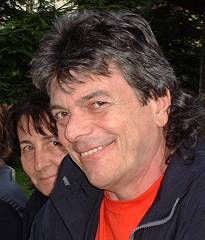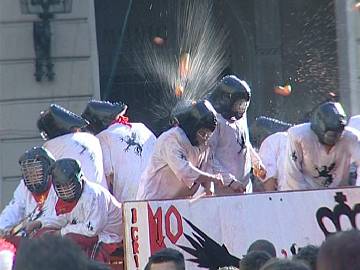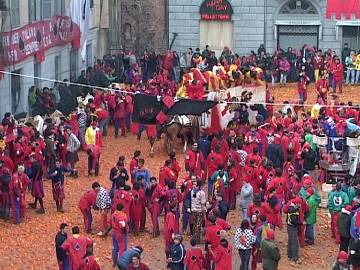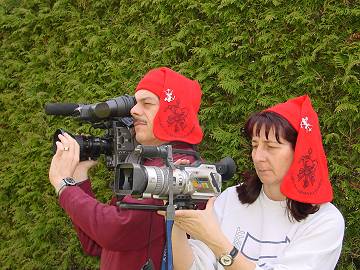
|
The world of non-commercial film and A-V |
Events Diary | Search | ||
| The Film and Video Institute | | ||||
The making of Battle of the Oranges
 This film won an International Medallion and the Best Documentary prize.
Bernhard is an extremely successful documentary film maker. Last year
he won the Editing Award for Waldesglut.
This film won an International Medallion and the Best Documentary prize.
Bernhard is an extremely successful documentary film maker. Last year
he won the Editing Award for Waldesglut.
Making The Movie
It was the 10th of January 2002, and I was still searching for a winning theme for my entry in the club-championship. It is the Videoclub Zillertal in Austria and I'm the chairman. I founded it in December 1986 and have been club champion 17 times out of 18 chances. [www.vcz.at]
I had a newspaper in my hand in which I read about a very strange carnival custom. There were a few photos in the magazine and it really looked crazy. I showed my wife, Karin, the magazine and told her this is where we would be on our wedding anniversary on the 7th of February: Ivrea in Piemont in the north of Italy.
We made plans for the journey. I went on the internet and searched for "la battaglia delle arance" and landed on the official carnival website - www.comune.ivrea.to.it
Wow, such a lot information! I saw that there are so many people attending every year that I had to contact the tourist office for advice. Gloria Faccio was the angel who helped me quite a lot - she organised official "la stampa" (press-cards) for us. When we arrived in Ivrea, she told us all about the carnival. So Karin and I had no problem being in the middle of the main action thanks to our press-cards.
Karin filmed with the Sony 2000 and I had the Sony 300 (the big one). At first we had no plan, we just filmed and filmed and filmed… Of course we did not shoot everything - but all together there were 4 hours of tape at the end of our trip to Ivrea.
 Orange throwing teams in trucks need to wear protective clothes and helmets. |
|
We arrived there on Friday and went to our hotel, which was about 40 kilometres far away, because the town itself was packed.
On Saturday everything began. The festival opened with the "Mugnaia" (carnival queen) in the centre. It is strictly prohibited to be on the balcony when the "Mugnaia" is first presented … but I was standing there. A large firework show was the culmination of this very loud evening, because all the participating groups showed themselves off.
On Sunday we watched the people coming to Ivrea - and all the transport lorries full of oranges. At 2 p.m. the great spectacle began. Karin was standing on the balcony, so she was quite safe, but I was in front of the throwers and I was hit all the time. An orange on my head, three oranges on my chest, another orange in the middle of my lens …
At the end of the day I thought I had been dreaming: what we saw could not have been real. But It was reality as we could smell later, when we returned to our hotel. Our clothes had to stay in the boot of the car and Karin needed 2 or 3 hours to clean our cameras.
Monday and Tuesday - the battle went on - three days of oranges - smelling oranges, sometimes even eating some. Karin dared to stay close to the fighters, but that was not a good idea. Suddenly she was covered in juice, because a fighter filled her up with oranges - the camera included. Normally they take care of videographers and photographers, but in this case they did not.
Competitions
 We thought we had
a very good film and would easily do well in competitions. We were wrong.
We thought we had
a very good film and would easily do well in competitions. We were wrong.
At our club-championship we first got a silver medal and then, in the second round we went up to gold, but only 3 of 5 judges were for gold. I did not become club-champion with this film. (I did get that honour but with another movie called Diabolos - which you will see next year.) The reason for judges' doubts was simple, they did not consider throwing oranges very worthy and so they were against the film. In my opinion they should have looked at how the film was made and not just at its subject.
At the Tyrolean championship (the next level) the film got gold again (5:0) and became Tyrolean champion. But at the Austrian championship - the highest level in Austria - the difficulty recurred: the subject matter, the throwing of oranges, did not meet with the approval of the judges so the film only won a silver medal. That meant it had no chance of being sent to UNICA, although our film had won several festivals (Golden Diana International Film Festival in Klopeinersee, International Video Grand Prix in Liechtenstein and the International Windmühlencup in Dinslaken).
But then I became a member of a club in Liechtenstein, where I work. That meant I could send the film to UNICA in Blankenberge (Belgium) last year. We won a silver medal there. Karin and I could not believe it - a dream came true !
Finally
Well, what else can I tell you about this film? Not very much I think - I could not use a tripod because I had to be flexible. I was hurt all the time and my body was covered in stains, but this film made us happy. And I have to thank Karin, my wife. Normally she does not like to use the camera but in this case she did - and she did it well, I think.
- Bernhard Hausberger March 2006
Editor's note: during the period this film was made Bernhard was diagnosed with lung cancer. He went through chemotherapy which caused the loss of his fine head of hair and an operation. He is putting together a book and a movie about his experience.
Share your passions.

Share your stories.
